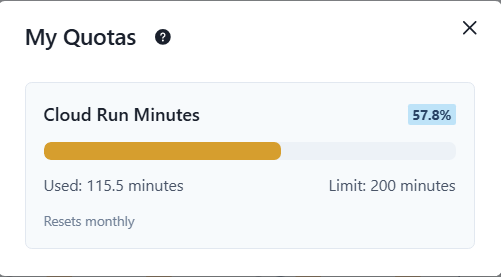Runtime Kernels¶
Free PlanqTN Cloud Runtime¶
Info
Running this service is a highly experimental effort, and is subject to change.
The cloud runtime requires no setup on the user's end, and is intended for educational, small-scale research use cases and experimentation. It is using Google Cloud Run to spin up weight enumerator calculation jobs that are subject to the following limitations:
- Memory: 1 GB RAM
- Execution time: 5 minutes
Network creation is executed through API calls to the Python framework using a Cloud Run Service, and is similarly subject to constraints:
- Memory: 512 MB RAM
- Execution time: 5 minutes
When the user runs into any of these limits, the job or API call will fail.
The current quota system is very simple:
- Every user gets 500 "Cloud minutes" per month.
- Each job execution costs 5 minutes (independent of the actual runtime length).
- Each API call costs 0.5 minutes.

Please reach out to planqtn@planqtn.com if you need to raise your quota, we'd love to hear your use case and thoughts on this.
Local Runtime¶
Using the same public planqtn.com UI, it is possible to switch to a local runtime.
System requirements:
- Docker (Desktop)
- NodeJS 22+
- minimum 12 GB Hard disk
- minimum 8 GB RAM
Installation steps:
- Setup
htnthe local tool for PlanqTN (the name ishfor Planck's constant and TN for tensor network)
pip install planqtn-cli
- Run the kernel
htn kernel start
This should spin up via the Docker container a Kubernetes cluster that will run and monitor the workloads for the jobs and the Supabase installation.
Checking Docker installation...
Running in dev mode, skipping directory/config setup, using existing files in repo
Job image: planqtn/planqtn_jobs:v0.1.13
API image: planqtn/planqtn_api:v0.1.13
Checking Supabase status...
Starting Supabase in working directory: ~/.planqtn/
Running database migrations...
Checking Docker network...
Setting up k3d cluster...
Setting up k8sproxy...
Testing k8sproxy...
Setting up job-monitor-rbac...
Setting up API service...
PlanqTN kernel setup completed successfully!
Now, on the PlanqTN Tensor Studio, use the Canvas menu to switch to a local runtime.
If htn kernel status command should provide something similar:
$ htn kernel status
Supabase: Running
k3d cluster: Running
k8sproxy: Running
API service: Running
Connection details:
{
"API_URL": "http://127.0.0.1:54321",
"ANON_KEY": "your anon key"
}
Copy-paste the JSON part, i.e. the lines below ``Connection details:''.
Self-hosted PlanqTN Cloud¶
As PlanqTN is fully open source, it is also possible to set up your own cloud instance, however, this is beyond the scope of the end-user documentation. For details, please check out the personal cloud setup details in DEVELOPMENT.md.